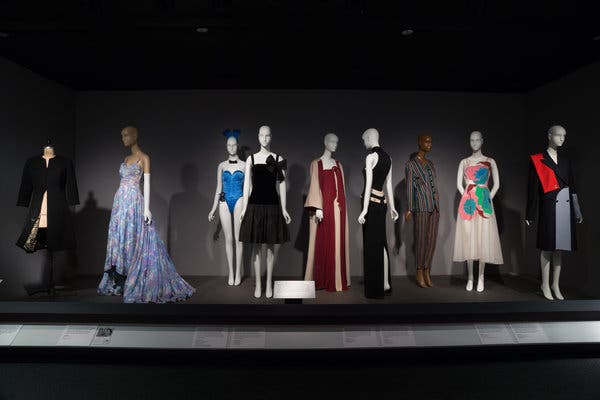In the mid-1950s, early in his career as a fashion designer, Arthur McGee had an identity problem of sorts.
“When I’d go to look for lines of fabric, I’d go to the fabric company, and they’d say, ‘Well, where’s the designer?’ ” he recalled decades later when he was being honored by the Metropolitan Museum of Art. “They’d walk right by me. And I’d say, ‘It’s me.’ ”
The slight, it seemed, was because of the color of his skin: Black designers were exceedingly rare at the time. As Newsweek put it in 1992, “Until recently, African-Americans were easy to find in the garment industry: They were the ones pushing the racks of dresses along Seventh Avenue.”
Mr. McGee, who died on July 1 at a nursing home in Manhattan, was a pioneer on that street, the heart of the city’s fashion industry: He was thought to be the first black designer to run the design room of an established Seventh Avenue concern, the Bobbie Brooks line. The cultural historian Aziza Braithwaite Bey, who once worked for Mr. McGee, said that he died after a long illness resulting from a series of aneurysms. He was 86.
Mr. McGee was a quiet force in the business for decades, dressing celebrities as well as creating functional clothes for retail outlets like Saks Fifth Avenue, Bloomingdale’s and Bonwit Teller. Dr. Bey said Mr. McGee had a talent for blending ancient cultures and contemporary style.
“His classic designs, whether created in the ’60s, ’70s, ’80s or ’90s, could be worn today,” she said.
Along the way he mentored other designers of color.
“Arthur was not a firebrand,” Harold Koda, the former curator in charge at the Costume Institute of the Metropolitan Museum of Art, said by email. “Instead his confidence in his own talents was like water seeping into the hard rock of racism — effortless seeming, but effective in breaking through.”
Dr. Bey was one of those who benefited from his guidance.
“He mentored working designers and fashion students nationally and internationally,” she said by email. “He was my mentor when I returned from studying haute couture in Paris in 1965. He taught me important skills of the trade and how to navigate in a fairly inhospitable industry.”
Though Mr. McGee helped bring more diversity to the business, he was clear in how he wanted to be defined.
“We are not ‘black’ designers but American designers, the way Bill Blass is an American designer,” he told Newsweek. “As soon as you categorize us, you can erase us.”

CreditThe Museum at FIT
Arthur Lee McGee was born on March 25, 1933, in Detroit. His father, George, worked in road construction. He cited his mother, Rose, who was a skilled clothes maker, as his earliest influence.
“She could make anything,” he said in 2009 in a video made by the Metropolitan Museum of Art. “She would take a piece of newspaper and make it into a pattern, then make a garment out of it.”
At 18 Mr. McGee won a design competition sponsored by the Traphagen School of Fashion in Manhattan, earning him a scholarship to study there, and he also attended the Fashion Institute of Technology. His mother had loved hats, and as a teenager he had made her some, so he was put in the millinery division there.
“I stayed in school for maybe six months, then I quit,” he recalled in the video, “because they said to me, ‘There’s no jobs for a black designer.’ ”
He had begun working for the designer Charles James while still at the institute, and was also doing his own designing. In the early 1960s he opened a shop on St. Marks Place in Manhattan. Later he had a store in Miami. In the late 1960s and early 1970s he was head designer for College Town of Boston and other lines.
Prominent figures from the Dance Theater of Harlem, Broadway and Hollywood began to seek him out. Among the fans of his clothes was the actress Cicely Tyson, who was once a fashion model.
“When I wore them, I always felt like I was floating,” she said in 2009 at a tribute to him organized by the Costume Institute.
In a 2018 episode of the PBS series “Antiques Roadshow,” someone brought in an outfit that Mr. McGee had made for the saxophonist Dexter Gordon to wear to the Academy Awards when he was nominated for an Oscar for the 1986 film “ ’Round Midnight.” Laura Woolley, the expert who assessed the outfit, appraised it at $5,000.
When not designing for celebrities, Mr. McGee kept practicality in mind.
“These clothes were all at a certain price range,” he said in the 2009 video, describing his general-public designs, “and you could always wear them, and you could get new ones added to the old ones. And that’s the way the market looked then. Now you can’t wear any of the stuff that you buy; it costs two arms and three legs, plus some more. It just doesn’t work.”
Mr. McGee’s survivors include a brother, Gordon.
Mr. Koda, who was leading the Costume Institute when Mr. McGee was honored, recalled a particular creation.
“A quintessential design of Arthur’s is an evening dress made for a favored client,” he said. “He had acquired an astonishing length of mud cloth with its characteristic airy, calligraphic geometries. He whipped it into a ball gown skirt with a sumptuous shoulder wrap to be worn with a shell or a sweater. Like a perfect jazz riff, it was a spontaneous, unforced expression of its parts: the relaxed vocabulary of American sportswear animated by the aesthetics of African tradition.”







